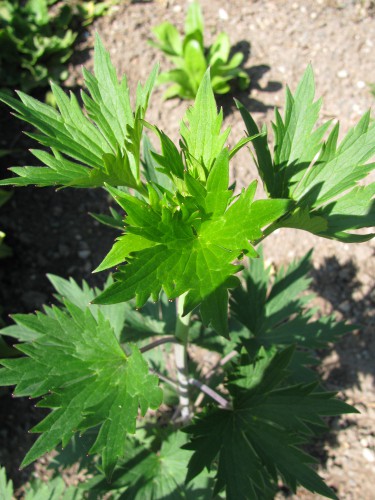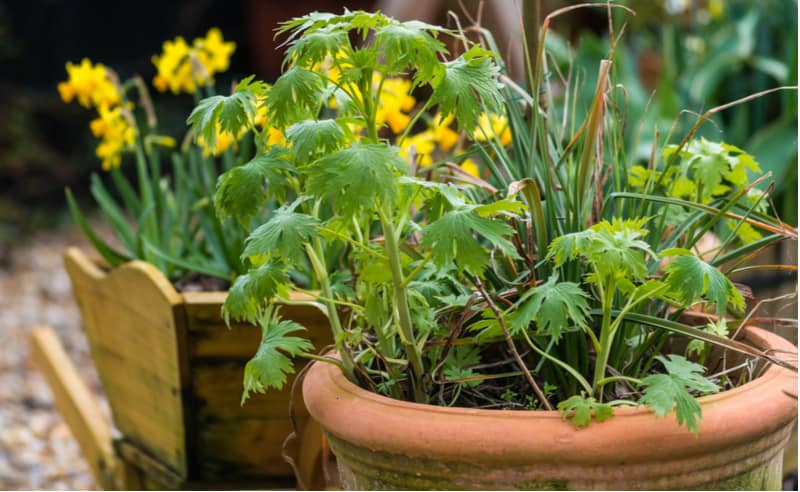Last updated on May 5th, 2022
Our site is reader supported, this means we may earn a small commission from Amazon and other affiliates when you buy through links on our site.
Delphiniums need to be divided regularly, usually every three years to get the most out of them. It’s important that you divide your Delphinium at the beginning of spring, right when you begin to notice the signs of new foliage. Doing so is important to the overall well-being of your garden. If you want your Delphinium to be a long-living plant that’s vigorous and healthy, make sure you divide them regularly.
How to divide your Delphiniums
Water plants the day before to ensure its well hydrated
Start by preparing the day before you to make your divisions to ensure the plant is fully hydrated but not soggy. This means watering the plant generously. The reason you want to do this ahead of time is that the process of dividing a plant can be quite stressful on the root system so ensuring it’s well-watered will ensure it establishes itself more easily when it is replanted. Preparing it by giving extra water beforehand will help the roots to become heavily saturated and reduce the shock of the division process.
Remove any excess foliage if needed
To help reduce the strain, cut back any excess foliage by approximately one-third. This will also go a long way toward reducing any unnecessary stress on the roots. If your plants only have a little foliage then they will be fine left as they are, you only want to remove any long stems and foliage.
Learn more about growing Delphiniums in pots in this guide here

Prepare the new holes for planting
If you are going to plant the divisions in your garden in new positions, prepare the holes beforehand. Using a spade, dig the holes and make sure they’re slightly larger than the plant but not as large as the original plants because you will, of course, be taking your divisions from the original plant which means they will become slightly smaller in size. You might get 4 or 5 new divisions from an established Delphinium in your garden.
You also want to adequately space out your holes if you are going to take more than one division from a single plant or perhaps for multiple plants. This will allow enough space for your new Delphiniums to grow without becoming too crowded.
Planting new divisions into pots
If you are planning to give some of the divisions to a friend or family member, or perhaps you want to grow them in pots because you don’t have a suitable position for them yet, you can prepare the pots into which they will be transplanted. We recommend using a good quality potting compost, ideally soil-based (such as John Innes potting compost) but mix a little grit through to improve drainage.

The whole process step by step
- Start by digging around the plant, approximately 20cm away from the plant itself. When you dig out your Delphinium, you don’t want to damage the roots and most of the time the roots won’t extend any further than that. Dig around the root system at an angle at various points until you can lift the entire plant safely from the ground. You can also divide plants grown in pots by simply removing them from their pot.
- Place the plant in a bucket in a location away from direct sunlight and cover it with newspaper. You want the roots to stay moist and to prevent any loss of moisture. If your plant is drying out while you are preparing the new hole, you can spray the newspaper with water on top. If you divide plants on a cool dry day this shouldn’t be an issue.
- Add organic matter to the hole from which you remove the Delphinium to help renew the soil. Homemade garden compost is great for this.
- Gently pull apart your plant being careful not to break the roots in the process. You should be able to divide newer sections that are about 20% the size of the original plant. Remember that Delphiniums multiply quickly so they will double in size within the first year so if you divide the plant into sections that are too big, you’re only going to have to divide them again the following year. A decent clump will usually divide into 4 pieces.
- Place the divisions in the ground so that the top of the roots remain level with the soil surface and backfill the hole with quality compost and then water it thoroughly.



2 Comments
this did NOT work and I am now worried that I may have unnecessarily disturbed my plant in the attempt to follow these instructions. The plant root mass was very clumped and could not be easily pulled apart as it was all connected to a harder wood root system in the middle. I put the roots in water to try and remove the soil and tease gently apart but this did not work so I just replanted the entire clump back in the original place, the only benefit being the additional organic matter that i had added to the original hole. I truly hope it will be ok and still bloom this summer as it is my garden favorite. It is on it’s 4th year so I though it was time to divide but I was wrong. Next year if the plant survives I may just try basal cuttings instead. Please do not try what this article says – it is wrong!
Hi, maybe the article wasn’t clear enough. If you can tease the roots apart then this is what you would do. However, quite often because delphiniums have fleshy roots it can require cutting with a spade or knife. I always aim to produce clumps containing three to five healthy shoots. Basal cutting is another way and I highly recommend it but the issue with this is you don’t really reduce the clump size and the main plant. Hope this helps.